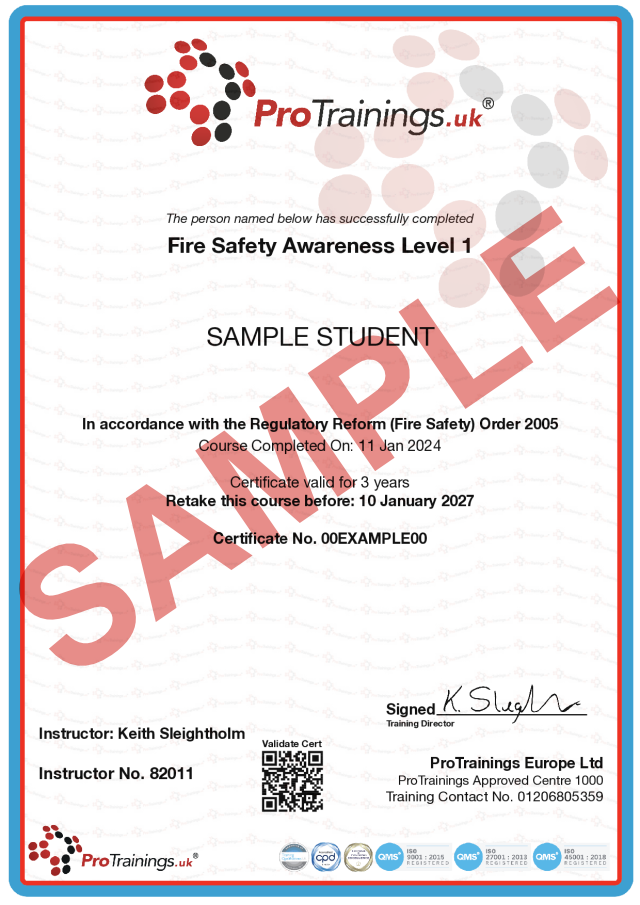Fire Safety Awareness Level 1
Fires can be absolutely devastating to a workplace, so learn how to prevent and respond to Fire Emergencies.
Fire Safety Awareness Level 1 at a glance
- 3-year nationally recognised certificate
- 1 hour and 5 minutes of engaging video training
- Video access for 8 months
- Printable wall certificate
- CPD time credit conformation
- Free weekly video refresher
- Evidence Based Training certificate
- Videos include subtitles
- Covers workplace and home fire safety
- Meets latest HSE and Fire Regulatory Reform Order (Fire Safety) recommendations
This level 1 course is aimed at anyone who requires a course in fire safety. The course is designed to meet and comply with the Regulatory Reform (Fire Safety) Order 2005. It covers regulations, the fire triangle, evacuation, fire equipment, good housekeeping, the law, training requirements, calling the fire service, fire doors, smoke alarms, risk assessing and precautions. We also offer a Level 2 course that training for Fire Wardens and Fire Marshals.
This course is ideal to give all members of staff basic fire training to increase awareness and cooperation in the event of a fire in the workplace. Awareness will reduce the risk of fires actually breaking out and therefore save lives.
Please note that learners undertaking a ProTrainings Trainings Course have the option to choose to take a regulated qualification.
The content of this and all our courses has been independently certified as conforming to universally accepted Continuous Professional Development (CPD) guidelines and come with a Certified CPD Statement as well as a ProTrainings Certificate and for online courses an Evidence Based Learning statement.
- Induction training
- Refresher fire training
- Any staff member
- Self-employed
This course comes with 3.0 hours of CPD, although the time to complete the course online may be less than this. Total course time includes 1 hours and 5 minutes of video training as well as knowledge reviews, final test, remedial help and reviewing downloaded material.
The content of this and all our courses has been independently certified as conforming to universally accepted Continuous Professional Development (CPD) guidelines and come with a Certified CPD Statement as well as a ProTrainings Certificate and for online courses an Evidence Based Learning statement.
- The Importance of Fire Safety
- The Law
- The Problem and How you Get Harmed
- Causes, Prevention, Training and Alarms
- The Fire Triangle
- Sources of Ignition
- Active and Passive Fire Spread
- Arson
- Aerosols
- Fire Prevention
- Good House Keeping
- Training and Staff Awareness
- Dangers of Smoke
- Types of Fire Alarm
- Emergency Equipment and Response Actions
- Fire Equipment
- Calling the Fire Service
- Fire Extinguishers
- Breakdown of a fire extinguisher
- Fire Hoses
- Fire Alarm Systems
- Evacuating in an Emergency
- Fire Doors
- Fire Blankets
- Fire Warden Kits
- Appropriate CLothing
- Smoke Alarms in the Home
- Fire Proofing the Home
- Risk Assessment and Hazards
- Formal Risk Assessment
- Review of fire safety
Learning Outcomes
1 Understand basic fire safety and what to do in the event of an emergency
1.1 State the main causes of fires in the workplace.
1.2 Outline the main costs of fires in the workplace for employers, employees and society.
1.3 State their own duties and responsibilities in relation to fire safety at work.
1.4 State the duties and responsibilities of fire wardens and other people who may be required to take action as part of fire risk controls or during an emergency.
1.5 Describe the action to be taken in the event of a fire in the workplace, including methods of raising the alarm and contacting the emergency services.
2 Understand the principles of fire risk control
2.1 List the key elements for effective fire risk management in the workplace.
2.2 Outline how the components of the fire triangle can be used to control fire risks.
2.3 List active and passive fire risk control measures.
2.4 Outline fire prevention measures that can be taken to minimise fire risks.
3 Understand the basics of practical fire safety
3.1 State the safe operating parameters for the use of portable fire-fighting equipment.
3.2 Outline simple checks for ensuring that fire safety equipment is serviceable and safe to use.









